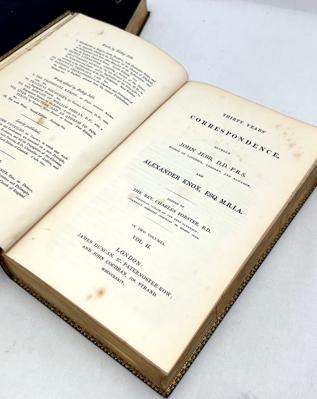
1 minute read
E.C. RARE BOOKS


Advertisement
Booksellers of Antiquarian Books & Ephemera

SPECIALIZING IN CHILDRENS ILLUSTRATED BOOKS, FINE BINDINGS, FORE - EDGE PAINTINGS, SETS, CLASSIC LITERATURE, VOYAGES & TRAVELS.
Hatchard’s and son Piccadilly. A beautiful combination of blind and gilt tooling in excellent condition.
FORE-EDGE PAINTINGS
Scenes of Dorset – Lyme Regis – Ockford –Cattistock such as the four equally spaced, pointed segmental, ashlar ribs still form part of the structure
This incredibly detailed Fore-edge painting on Vol I is a church and street view of Okeford fitzpaine. In 1086, the Domesday Book recorded Okeford Fitzpaine as Adford; it had 40 households, 16 ploughlands, 21 acres (8.5 hectares) of meadow and one mill. It was in Sturminster Newton Hundred and the tenant-inchief was Glastonbury Abbey. Since then, it has been known as "Aukford Alured" and "Ockford Phippin", the latter echoing the modern colloquial "Fippenny Ockford" and its shorthand, "Ockford".
Vol. II is even more detailed and split into three individual scenes.
Buddle Bridge, Lyme Regis. Believed to be the third oldest bridge in Dorset, Buddle Bridge is a delightful Grade I listed bridge hidden under the main road through Lyme Regis. Of both historical and archaeological significance, this medieval gem is best viewed looking back from Gun Cliff Walk or from the beach below at low tide. According to The Lyme Regis Society, the bridge has one arch, circa 1200-1240, which survives in a nearby cellar. The bridge, which carries Bridge Street over the river Lim, has been adapted many times although some of the original fourteenth century medieval masonry
Cattistock Dorset. Cattistock is a village and civil parish in west Dorset, England, sited in the upper reaches of the Frome Valley, eight miles (13 km) northwest of the county town Dorchester. The Dorset poet William Barnes called it "elbowstreeted Cattstock", a comment on the less-thanlinear village street.
Lyme Regis Dorset. In Saxon times, the abbots of Sherborne Abbey had salt-boiling rights on land adjacent to the River Lym, and the abbey once owned part of the town. Lyme is mentioned in the Domesday Book of 1086. In the 13th century, it developed as one of the major British ports. A Royal Charter was granted by King Edward I in 1284 when "Regis" was added to the town's name. The charter was confirmed by Queen Elizabeth I in 1591.






